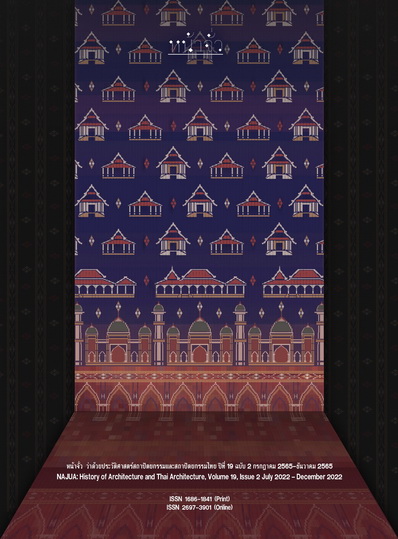Architectural Development of Mosques in Pattani Province
Main Article Content
Abstract
This research article explores the architectural changes of mosques in Pattani Province that occurred in the midst of changing social, economic and political conditions. The scope of the study is from the spread of Islam in Pattani Province in the 19th century to the present days. The research asks what factors contributed to the change and existence of mosque architecture in Pattani. This qualitative research was conducted using a total of 7 mosques: Aho Mosque, Najmuddin Mosque, Krue Se Mosque, Dato Mosque, Rayafatani Mosque, Raya Mosque, and Central Mosque of Pattani Province. The criteria for the selection are from case studies related to the history of Pattani and the ones that appear to have significant changes in architectural style, distinctive from the previous mosques in Pattani. Drawing upon field surveys, maps, photographs and in-depth interviews, the study then analyses the changes in architectural styles.
The finding reveals that the factors that caused the change in the architecture of mosques in Pattani Province came from two principal causes. First, the internal factor: the adoption of local architectural styles as an inspiration for the formation of present mosque architecture. Second, external influences: the appropriation of architectural styles from Persian culture to the architecture of mosques in Pattani. By adopting the Mughal architectural style and onion-shaped domes, the Central Mosque of Pattani served as a popular model for other mosques in Pattani Province and neighbouring provinces.
While the architectural style of mosques in Pattani has changed over time, such changes occurred merely externally. The layout of the mosques remains oriented along the East-West longitudinal direction. The front of the mosque always faces Eastward, to facilitate users who enter the building to turn westward to Qibla's direction when praying. Nowadays, the mosque continues to serve as the centre of the community. Especially on Friday as well as other religious days, people in the community will gather at the mosque. This reflects the importance of the mosque and the strict adherence to the teachings of Islam of the people in Pattani.
Downloads
Article Details

This work is licensed under a Creative Commons Attribution-NonCommercial-NoDerivatives 4.0 International License.
References
Binji, Arifin, Abdullah La-Orman, and Suhaimi Ismail. pā tānī prawattisāt læ kānmư̄ang nai lōk malāyū [Patani: History and Politics in the Malay World]. 3rd ed. Songkhla: Southern Islamic Culture Foundation, 2013.
Chaiwat Satha-Anand. khwāmrunrǣng kap kānčhatkān khwām čhing Pattānī nai rō̜p kưng satawat [Violence and managing: “Reality” in Pattani for the past fifty years]. Bangkok: Thammasart University press, 2008.
Krongchai Hatta. matsayitkrư̄se mō̜radok ʻārayatham Pattānī [History of Krue Se masjid in Pattani province]. Pattani: Good idea, 2003.
Krongchai Hatta. Pattānī kānkhā læ kānmư̄ang kān pokkhrō̜ng nai ʻadīt [Pattani: Trade and politics in the past]. Pattani: Mittapap Press, 1998.
Krongchai Hatta. prawattisāt Pattānī samai ʻānāčhak bōrān thưng kān pokkhrō̜ng čhet hūamư̄ang [History of Pattani from the ancient kingdom to the reign of seven states]. 2nd ed. Bangkok: Chulalongkorn university press, 2009.
Ministry of Interior. prawat mahātthai sūan phūmphāk čhangwat Pattānī [History of the Ministry of Interior in the region of Pattani province]. Bangkok: Bangkok Sarn Publishing, 1985.
Piyada Chonlaworn. prawattisāt Pattānī nai Khritsatawat thī siphok - sippǣt čhāk banthưk khō̜ng Čhīn riokio læ Yīpun [History of Pattani kingdom, southern Thailand, in the 16th century to 18th century; A study from Chinese, Ryukyuan, and Japanese historical sources]. Chiang Mai: Silkworm Books, 2011.
Pornpawee Sringam. “pati samphan thāng watthanatham khō̜ng chumchon mư̄ang Pattānī [The cultural interaction of the community of muang Pattani].” PhD dissertation, Thaksin University, 2012.
Raksamani, Adis Idris. Matsayit nai Krung Thēp mō̜ng prawattisāt sangkhom Mutsalim tangtǣ sāng Krung Thēp-Phō̜.Sō̜. sō̜ngphanhārō̜ihāsipsō̜ng phān sathāpattayakam matsayit [Mosques in Bangkok: History of Muslim societies from the beginning of Bangkok to 2009 through history of mosques]. Bangkok: Matichon, 2014.
Syukri, Ibrahim. prawattisāt rātchaʻānāčhak malāyū pa tānī [History of kingdom of Malayu Pattani]. Translated by Hasan Madmarn and Mahamasaki Jaeha. Chiang Mai: Silkworm Books, 2006.
Vassan Cheevasarth. “sathāpattayakam thāng sātsanā khō̜ng chumchon chāo Thai Mutsalim nai čhangwat Pattānī [Religious architecture of the Thai muslim communities in Pattani].” Final Report. Prince of Songkla University, 2001.
Virunha, Chuleeporn. “Sayām kap Pattānī nai samai ratchakān thī nưng-sō̜ng hǣng krung Rattanakōsin: kāntham khwām khao kīeokap songkhrām læ kān bǣngyǣk Pattānī ʻō̜k pen čhet hūamư̄ang [Siam and Pattani during the first two reigns of Rattanakosin era: Toward the understanding of war and the division of Pattani into 7 principalities].” Journal of the Faculty of Arts, Silpakorn University 35, 1: (January-June 2013) 11-53.
Yongyut Chu–Waen. “prawattisāt khwāmsamphan rawāng Sayām kap Pattānī kō̜n samai Rattanakōsin [Historical relationship between Siam and Pattani before the Rattanakosin period].” Journal of Security Studies, no. 68 (November 2009): 1-43.


